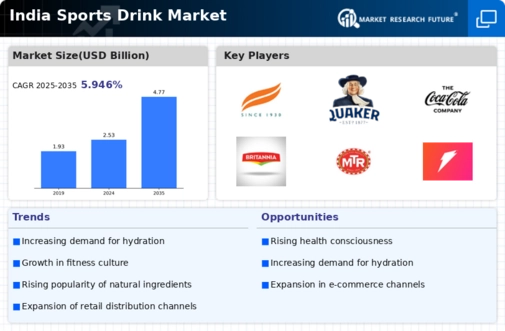Rising Fitness Culture
The increasing emphasis on fitness and wellness among the Indian population appears to be a pivotal driver for the sports drink market. With a growing number of individuals engaging in physical activities, the demand for hydration solutions that support athletic performance is likely to rise. According to recent surveys, approximately 30% of urban Indians are now participating in regular fitness activities, which correlates with a heightened interest in sports drinks. This trend suggests that consumers are seeking products that not only quench thirst but also replenish electrolytes and provide energy. Consequently, brands are adapting their offerings to cater to this fitness-oriented demographic, thereby expanding their market presence. The sports drink market is thus positioned to benefit from this cultural shift towards healthier lifestyles, as consumers increasingly prioritize products that align with their fitness goals.
Rising Disposable Incomes
The increase in disposable incomes among the Indian middle class is another significant factor influencing the sports drink market. As consumers have more financial resources at their disposal, they are more likely to invest in premium products that promise health benefits and enhanced performance. Reports indicate that the middle-class segment is expected to grow by 10% annually, leading to greater spending on health and wellness products, including sports drinks. This trend suggests that the sports drink market could capitalize on the willingness of consumers to pay a premium for quality and efficacy. Brands that position themselves as health-oriented and premium are likely to attract this demographic, thereby driving market growth. The interplay between rising incomes and consumer spending habits is expected to shape the future landscape of the sports drink market.
Growing Youth Demographics
The demographic shift towards a younger population in India is a critical driver for the sports drink market. With over 50% of the population under the age of 25, there is a burgeoning market for products that cater to the preferences and lifestyles of younger consumers. This demographic is increasingly health-conscious and inclined towards active lifestyles, which suggests a growing demand for sports drinks that offer functional benefits. The sports drink market is likely to see innovations in flavors and formulations that appeal to this age group, including low-calorie and natural ingredient options. Additionally, marketing strategies targeting youth through social media and influencer partnerships may further enhance brand engagement. As this demographic continues to expand, the potential for growth in the sports drink market appears promising.
Influence of Sports Events
The growing popularity of sports events in India, such as cricket and football leagues, is likely to have a substantial impact on the sports drink market. Major sporting events often lead to increased viewership and participation, which in turn drives demand for sports drinks among fans and athletes alike. For instance, during the IPL season, sales of sports drinks reportedly surge by approximately 25%, as fans seek to emulate their favorite players. This trend indicates that the sports drink market can leverage these events for promotional activities and brand visibility. Furthermore, partnerships with sports teams and sponsorships of events can enhance brand recognition and consumer loyalty. As the sports culture continues to flourish in India, the correlation between sports events and sports drink consumption is expected to strengthen, providing a robust avenue for market growth.
Increased Availability of Products
The expansion of distribution channels for sports drinks in India is another significant driver impacting the sports drink market. Retailers are increasingly stocking a variety of sports drink brands, making these products more accessible to consumers. The rise of e-commerce platforms has further facilitated this trend, allowing consumers to purchase sports drinks conveniently from home. Reports indicate that the availability of sports drinks in tier 2 and tier 3 cities has increased by over 40% in the past year, reflecting a growing market potential. This enhanced accessibility is likely to encourage trial and repeat purchases among consumers, thereby driving overall market growth. As the sports drink market continues to evolve, the focus on improving distribution networks will be crucial in meeting the rising demand for these products across diverse consumer segments.






















Leave a Comment